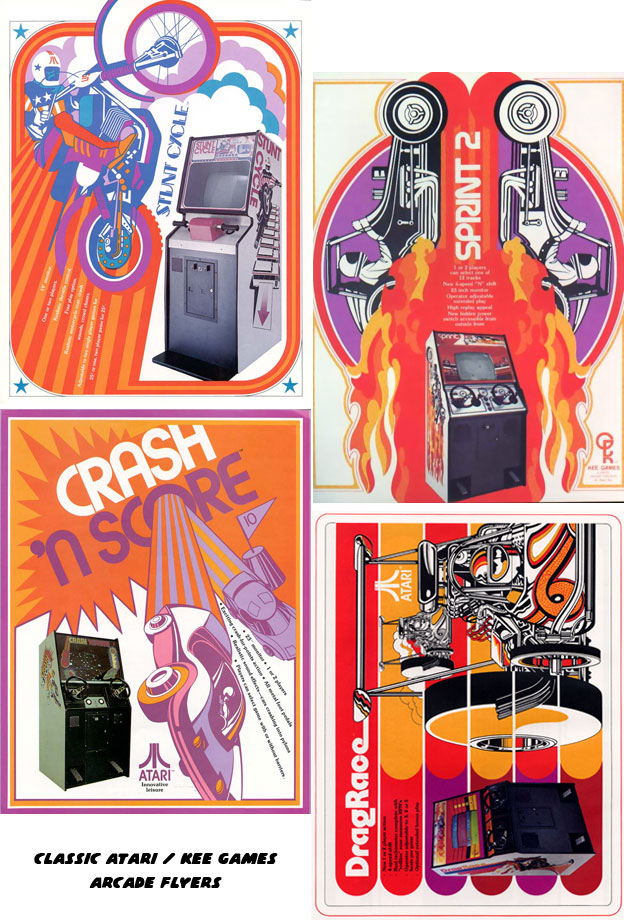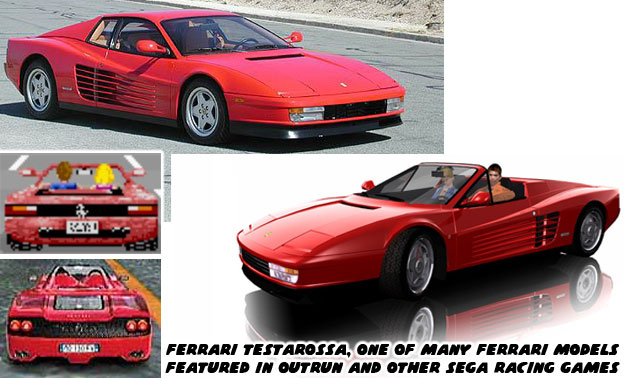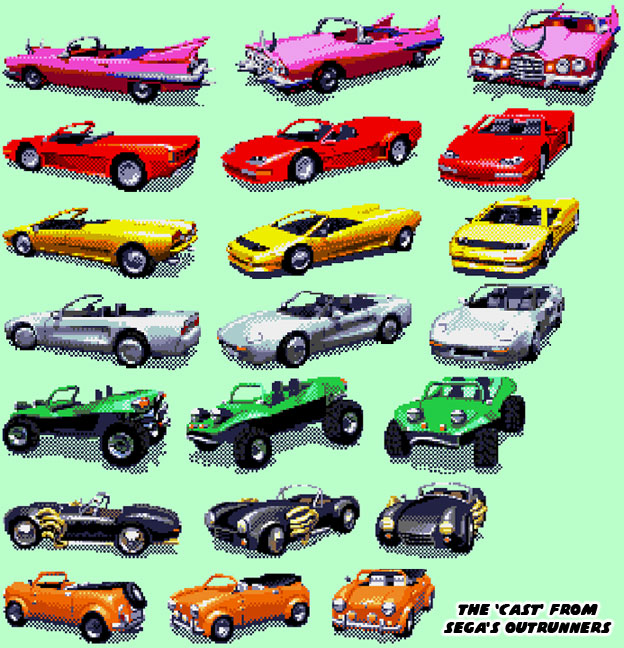Some of my earliest memories of going into the arcade were seeing the brightly colored arcade cabinets. Atari seemed to have a new racing game every time I visited. The graphics and gameplay on the early titles were not very realistic. Cars and motorcycles were a few blocky pixels and gamers really had to use their imagination to fill in the blanks. It was the cabinet art that really spurred my imagination. The bold colors and stylish designs of late '70s graphic artists were striking. Many of the illustrations would undoubtedly go over well today as a retro tee shirt design.

Whether in the USA, Japan, England or Europe, there were countless racing fans working in the computer industry. Those that became successful with a program, application or platform went on to buy the fastest and flashiest cars that they could. In Silicon Valley the nicest cars either belonged to the venture capitalists that backed companies like Atari, Apple, Oracle or any number of upstarts in the San Francisco Bay Area. The nice cars sometimes belonged to the young engineers that were on the ground floor when the companies started trading publicly. These developers and designers were looking for ways to make computer games and arcade games more realistic. They were also looking to make games about the things they loved. Racing was therefor an early favorite for arcade developers in Japan and the US.
One designer in particular had a strong passion for Ferrari super cars like the Testarossa. The man was Yu Suzuki and the company he worked for was Sega. One of his most successful titles was a racing game named OutRun. Released in 1986 the game featured a red convertible that looked strikingly like the Testarosa. It even included a familiar "Dancing Horse" logo on the rear which looked like the Ferrari badge. Sega would not have the rights to the Ferrari name for another decade. Not until Suzuki produced SCUD Race in 1996, which featured the Ferrari F-40 but also included rival super cars the McLaren F1, Porsche 911 and Dodge Viper. As much as Suzuki loved the Ferrari he knew that the rest of the world had also developed amazing supercars as well and they deserved to be in the game. Before SCUD Race the red convertible in the Sega racers was known simply as the "Speed Buster."

Throughout his career at Sega Mr. Suzuki constantly pushed his teams to break new ground on each and every title they created. As the leader of AM2, the Sega Amusement Machine Research and Development Team 2, he was tasked with helping develop hardware that was cutting edge and software that took full advantage of it. His work in 2D and 3D titles spans almost 30 years. Hits include Virtua Fighter, Shenmue, Virtua Cop and After Burner. The scope of his influence may never be fully appreciated by the game industry but his titles will certainly live on.
Suzuki greatly improved from the development of Hang-On, a motorcycle racing game that was released a year prior to OutRun. The multiple branching paths that the Speed Buster could take, the complexity in the stages and animations had been bumped up considerably from what arcade players had seen just prior. Sega was always one of the most innovative arcade developers in the early days of the industry. They created one, if not the first arcade racer in color, Monaco GP in 1979. Atari by contrast had Sprint 2 (player) in 1976 and Sprint 1 in 1978 and both of which were in black and white and far more limited experiences. Sega was one of the trendsetters in a genre. Rather than trying to make the game player feel like they were controlling a driver in a racing game, they instead made the car the star. The driver and passenger in OutRun did have some memorable animations. Few could argue that the Speed Buster was not the true star of the game.

In 1993 the team at Sega AM1 produced OutRunners. It was a spiritual sequel to OutRun, the actual sequel produced by Suzuki would not appear until 2003. They expanded on the mechanics of the game, the graphics, courses and most notably the car selections. Each participating nation had a team of drivers, that varied from the silly to the serious. Again it was the cars that were the true stars of the game. Each car performed differently. No two handled quite the same and each had a distinct advantage and disadvantage, such as the ability to accelerate or recover from a crash faster than the other cars. The Speed Buster finally had a rival sports car in the virtual world, a bright yellow convertible named the Mad Power which resembled a Lamborghini Diablo. It was joined by other cars like the Bad Boy, Smooth Operator and Wild Chaser, which resembled the Shelby Cobra, Porsche 914 and Meyers Manx respectively.
What Sega had demonstrated was that Suzuki was not the only car fanatic working at the studio. The developers understood and moreover appreciated the subtleties between the iconic cars from each nation. They were able to make amalgamations of popular vehicles without exactly settling on one brand. They were also demonstrating that some of the developers in the game industry were very good at trend spotting. The styling on several of the cars were not only good contemporary designs but also predicted the shape of sports cars and exotics yet to come. When developers realized that they did not have to lock cars into racing games then they went wild coming up with ideas. The next blog looks at the ways in which these cars began to shape gameplay.
If you would like to sponsor me
please visit my Patreon page and consider donating each month, even as little as $1 would help make better blogs and even podcasts!





The thing that stunned me about OutRun was the specs of the car were matched in the game the game did about 296 kph which translated to about 185 mph (Testarossa top speed euro model)
ReplyDelete